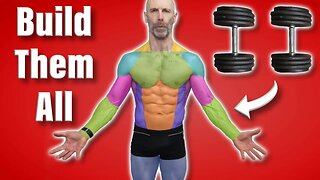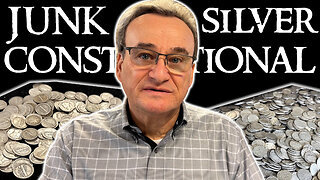High Volume Training Over 50 Years Old
High volume training over 50 years old
Today we are going to look at a study that I briefly mention in my video on “should we train to failure.” At the time I could only get a copy of the abstract, but thanks to a subscriber named Andrew, I now have the full study. The reason this study got my interest is it was done on older men and it came to the conclusion that volume was more important than training to failure when it comes to older weight training men.
If you are interested in losing body fat and adding muscle, please email me at 1shark1bite@gmail.com for information on my personal training services.
Facebook; https://www.facebook.com/Fit-and-50-548844435514900/
My Amazon page link; https://www.amazon.com/shop/fitand50
My Affiliate link to Lebert for their Equalizer bars and more; http://www.easywebautomation.com/app/?af=1679568 and use the discount code LFI20 you will receive 20 dollars off your purchase
High volume training over 50 years old
Now We’re going to take a closer look at this study and see how we might be able to use this information to benefit us in our own training. This was a 12 week study involving 52 healthy men these men were older with the average age of 66 the youngest participant was 61. So a little older than me, but one day I’m going to get there. Now none of them had done any training for at least 3 months before the study, and the impression I got was they were essentially untrained men. But that doesn’t matter because we can get fit and build muscle at any age.
This is where it got interesting they broke them into 3 groups. The first group trained their legs using the leg press and leg extension machine to failure for 2 sets. The second group did 50% of the repetitions to failure for 2 sets and the Third and final group did 50% of the reps to failure, but did this for 4 sets essentially equaling the volume of the group that trained to failure.
They did these exercises as part of a full body workout done twice a week. After which they did a cardio session.
With this information alone I would conclude the two sets to failure group would have the best muscle growth and strength gains.
On a side note all of the men in this study lost body fat with the most body fat being lost by the 4 set group. Their body fat percentage went down on average 1.4 percent over the course of this study. Their diet wasn’t tracked, but all the participants were told not to change their eating habits from how they were eating before the study started. So this body fat loss would have been without changing their diet.
One of the things they did with this study that I liked is they made it progressive. Every 4 weeks they would increase the weight with all 4 groups. From week 1 to 4 they lifted 65% of their one rep max. Weeks 5 to 8 they lifted 70% plus an additional 5% to take into consideration the participants increase in one rep max strength and from weeks 9 to 11 they increased to 80% again adding another additional 5% for continued strength gains.
So the actual volume of all of the participants went up over the course of this study irregardless of which group they were in.
I believe this is why the group that did 2 sets of only 50% of the reps to failure still made significant strength gains although it was less than the other two groups.
When it came to muscle growth, the train to failure group and the group that did 4 sets at 50% of the reps excelled, building almost the same amount of muscle size with close to equal strength gains. Whereas the 2 sets of 50% reps had no significant increase in muscle growth.
I would have though that the 2 sets to failure group would have done better as the volume was equal and they would have gone into the most effective rep range for building muscle which is those last few reps before failure. Now I’m not about to change the way that I train. I do Periodize my volume so there is often times when I’m training at quite a high volume, but much closer to failure as it is more difficult to build new muscle once your a advanced lifter.
There are those that can draw encouragement from this study. Those of us that love working out, enjoy the feeling of pushing our bodies to the limit. But not everyone does, especially when it comes to leg training, so as long as you slowly keep progressing the weight. Higher volume lower intensity work can still reap strength and hypertrophy benefits.
We do have a real world example of how training with lower intensity and slowly adding weight can be effective. This is with the Stronglifts program. I don’t personally do the Stronglifts, but there are a number of things about it I really like. One of them you start the program at 50% of your 5 rep max. Which would be a fairly light weight and slowly each workout add the smallest amount weight possible. Until they have worked their way back up to a new max.
-
 4:57
4:57
Fit and 50
1 year ago $0.08 earnedBuild Full Body Muscle at Home With Dumbbells Over 50 (Real Growth)
3261 -
 1:05:06
1:05:06
The New American
2 hours agoNew American Daily | Minnesota-based Award-Winning Journalist Exposes the Real Tim Walz
18.5K -
 12:55
12:55
Breaking Points
1 day agoUS Rushes CRUISE MISSILES As Iran, Israel ON BRINK
28.7K12 -
 17:15
17:15
Silver Dragons
3 hours agoCoin Dealer Reveals Best Junk Silver Coin for Silver Stacking
26.7K3 -
 1:04:11
1:04:11
Russell Brand
5 hours ago“They Will All Be JAILED!” Britain’s Post-Riots Authoritarian NIGHTMARE - SF 430
128K228 -
 1:59:19
1:59:19
The Charlie Kirk Show
4 hours agoTim AWOLz + Chicago's '68 Redux? | Hernandez, Morris | 8.14.24
104K21 -
 2:11:55
2:11:55
The Dilley Show
4 hours agoInsane Inflation and a Warning for November! w/Author Brenden Dilley 08/14/2024
46.7K11 -
 26:20
26:20
CartierFamily
16 hours agoLiberal Media FREAKS OUT as Trump and Elon’s X Interview Shatters the Internet!
33K25 -
 17:56
17:56
Neil McCoy-Ward
4 hours ago🚨 A Local FARMER Just Gave Me Some DISTURBING News (This Is About To Get UGLY!)
23.5K7 -
 58:53
58:53
The Dan Bongino Show
6 hours agoTHIS Is What I'm Worried About In The Coming Election (Ep. 2308) - 08/14/2024
638K2.36K